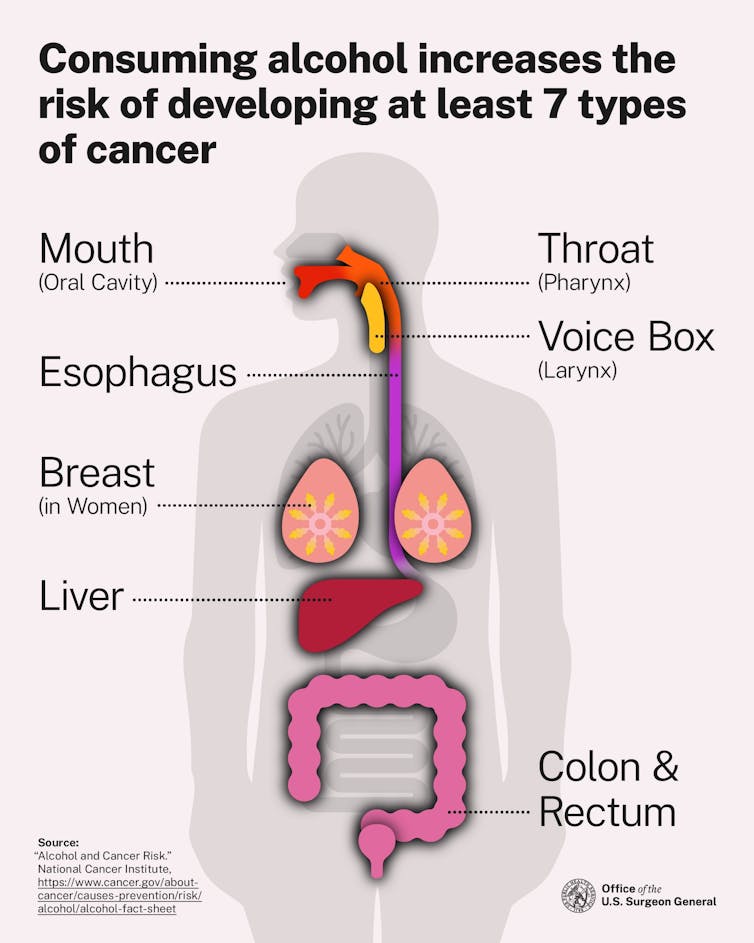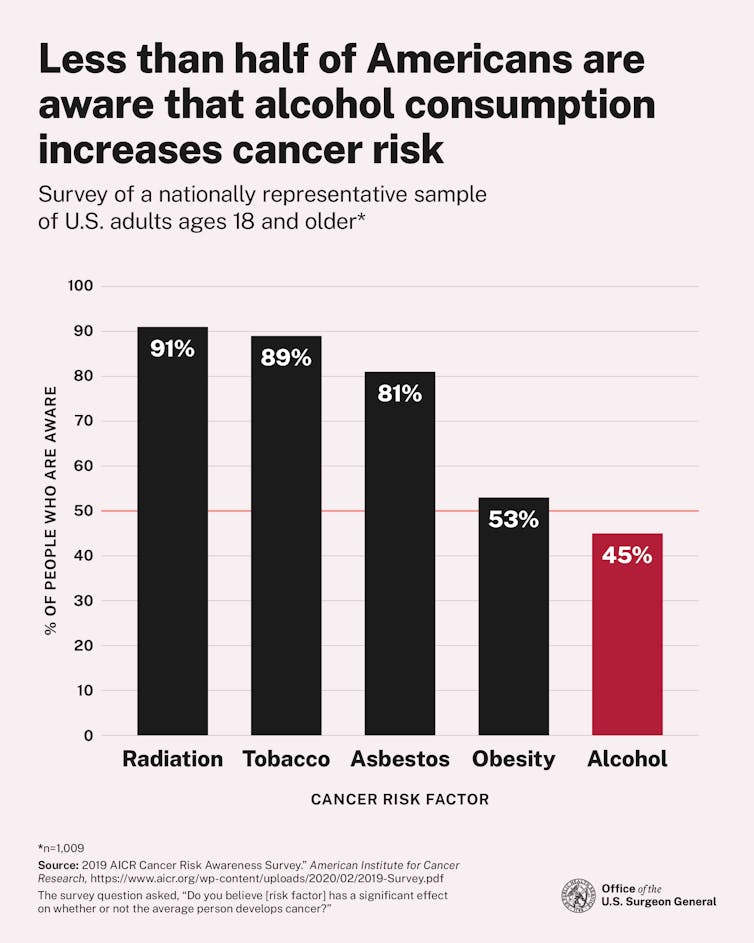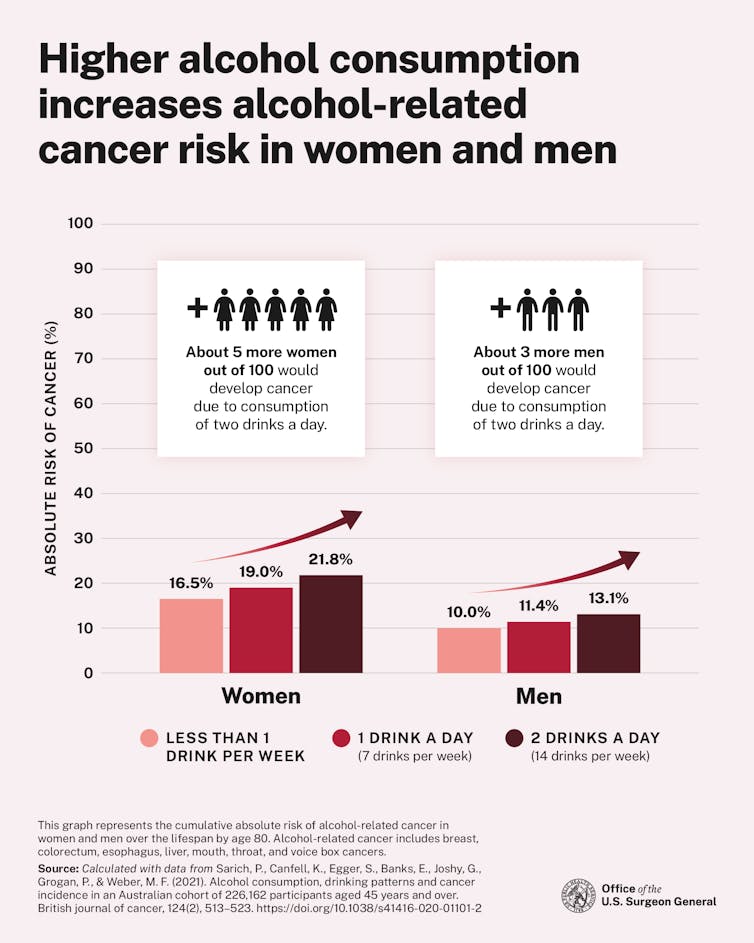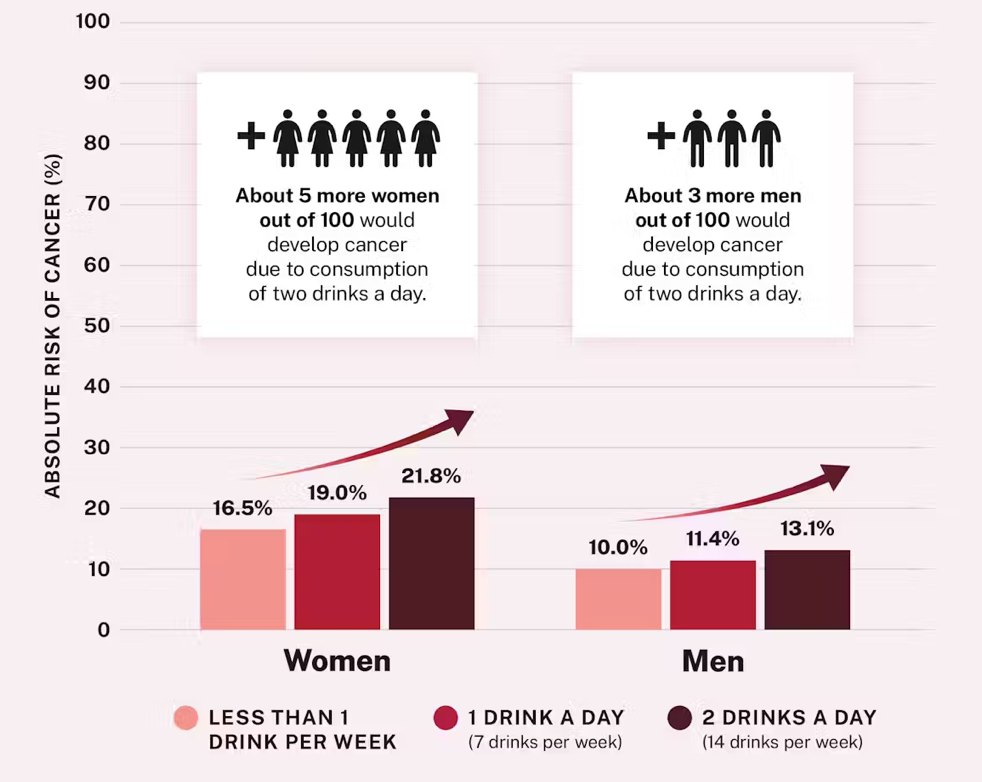Many people use the new year to reflect on their relationship with alcohol. Just-released government guidelines are giving Americans another reason to consider a “dry January.”
Over the past few decades, mounting scientific evidence has shown that as little as 1-2 alcoholic drinks per day can lead to increases in the likelihood of several cancers. This prompted the U.S. surgeon general, Dr. Vivek Murthy, to release a new Surgeon General Advisory on Jan. 3, 2025, warning about the link between alcohol and cancer. This report highlighted the evidence and included a call for new cancer warning labels on alcoholic beverages.
The association between alcohol and cancer isn’t new news – scientists have been trying to determine the link for decades – yet most people aren’t aware of the risks and may only associate drinking with liver disease like cirrhosis. In a 2019 survey from the American Institute for Cancer Research, less than half of Americans identified alcohol as a risk factor for cancer.
Alcohol is the third-most preventable cause of cancer in the U.S, putting it just behind tobacco and obesity. As the surgeon general’s report highlights, alcohol is associated with approximately 100,000 cancer cases and 20,000 cancer deaths every year, playing a role in breast, liver, colorectal, mouth, throat, esophagus and voice box cancer cases. Alcohol-induced cancer deaths outnumber alcohol-associated traffic crash fatalities every year.

Office of the U.S. Surgeon General
The report included the suggestion to add warning labels to alcohol similar to what is already required for tobacco products – another substance of abuse known to cause cancer.
As a neuroscientist specializing in the neurobiological effects of alcohol use and binge drinking, I am glad to see the call to action for reducing alcohol consumption in the United States.
Key takeaways of the report
With so few people aware of the links between alcohol consumption and various cancers – and the fact that the vast majority of people consume some alcohol every week – it’s easy to see why the surgeon general is calling for greater awareness. The 22-page report highlights what scientists know about the relationship between alcohol and cancer, and suggests actions for moving forward. Those include label changes on alcohol, which have not been updated since they were created in 1988.
Somewhat strikingly, breast cancer carries a large portion of this risk – making it particularly worrisome in the face of increased alcohol use among women.
These numbers don’t only apply to heavy alcohol drinkers. While less alcohol is better, 25% of these cancer cases were in people classified as moderate drinkers – consuming, on average, fewer than two drinks per day. This means that anyone regularly drinking alcohol, even small amounts, should know about and understand the risks.
Surgeon general’s advisories are the primary way that the Department of Health and Human Services, where the Office of the Surgeon General resides, communicate health issues of great importance to the public. Surgeon general’s advisories are not necessarily breaking news, but they take the opportunity to bring public awareness to science surrounding big public health issues.

Office of the U.S. Surgeon General
The science behind the link between alcohol and cancer
The relationship between alcohol and cancer has been clear to scientists for decades. In fact, it was highlighted in a 2016 surgeon general’s report as well, which focused on addiction more broadly.
The new report outlines the different types of evidence supporting this link. One way is through epidemiological science, which tries to understand patterns and relationships between the rates of cancer and how much alcohol people consumed. Another is through experimental animal studies, which allow scientists to understand the mechanism and causality of these connections as they apply to specific cancers. Together, studies conclusively show a link and pathway between alcohol consumption and cancer.
The surgeon general’s report highlights four key pathways through which alcohol can cause cancer. These largely focus on the ways alcohol can negatively affect your DNA, the building blocks of cells. While the healthy cells in your body divide all the time, their abnormal growth can be driven by aberrant factors like alcohol-induced DNA damage.
This DNA damage leads to uncontrollable growth of tissue instead of healthy, normal tissue growth. This abnormal tissue growth is cancer. The four pathways through which alcohol can lead to cancer highlighted in the report are:
- The body naturally breaks alcohol down into acetaldehyde. Acetaldehyde can damage and break DNA, leading to chromosomal rearrangements and tumors. This link is so strong that acetaldehyde has been classified as a carcinogen since 1999.
- Alcohol creates reactive oxygen species. Reactive oxygen species, sometimes called “free radicals,” are unstable molecules that contain oxygen and can further damage DNA, proteins and fats.
- Alcohol can influence hormones, like estrogen. Alcohol can raise the amount of estrogen in the body, which may explain its link to breast cancer. This increased estrogen can influence breast tissue by causing – you guessed it – DNA damage.
- Alcohol is a solvent, which means other things can dissolve in it. This makes it easier for carcinogens from other sources – like cigarettes and e-vapes – to be absorbed by the body when the two are consumed together.

Office of the U.S. Surgeon General
Is any amount of alcohol safe?
The biggest question on people’s minds right now is likely “how much alcohol can I safely drink?” and the answer to that might disappoint you – probably none.
Alcohol use remains one of the most preventable risk factors for cancer. And even moderate alcohol consumption – one or fewer drinks per day – may elevate cancer risk for some types, such as breast, throat and mouth cancers.
But none of these studies can tell you what your individual risk for cancer is. The relationship between alcohol and cancer can be influenced by your genes, such as those that control the enzymes that metabolize alcohol, and other lifestyle factors that influence the rates of cancer broadly, like diet and inflammation. All of these lifestyle and personal health factors can influence how risky alcohol consumption is for you.
The Centers for Disease Control and Prevention notes that if you choose to drink, consider sticking to less than one, for women, or two, for men, standard servings of alcohol per day – which might be smaller than you think, and don’t binge drink alcohol at all. The surgeon general is also suggesting a rethinking of these guidelines to include updated limits on daily alcohol consumption and greater educational efforts around the link between alcohol and cancer.
The National Institute on Alcohol Abuse and Alcoholism has similar recommendations around limiting alcohol consumption and advises that for people who choose to drink alcohol, “the less, the better.”
The institute offers tips on its website for managing your alcohol consumption or abstaining from alcohol consumption altogether, including finding alternative hobbies and activities, identifying what leads to your urges to drink and having a plan to handle urges, and identifying a strategy for saying “no” to an alcoholic beverage in social settings.![]()
Nikki Crowley, Assistant Professor of Biology, Biomedical Engineering and Pharmacology, Penn State
This article is republished from The Conversation under a Creative Commons license. Read the original article.

